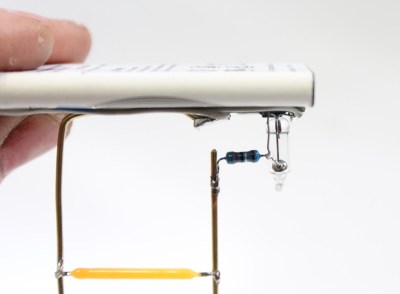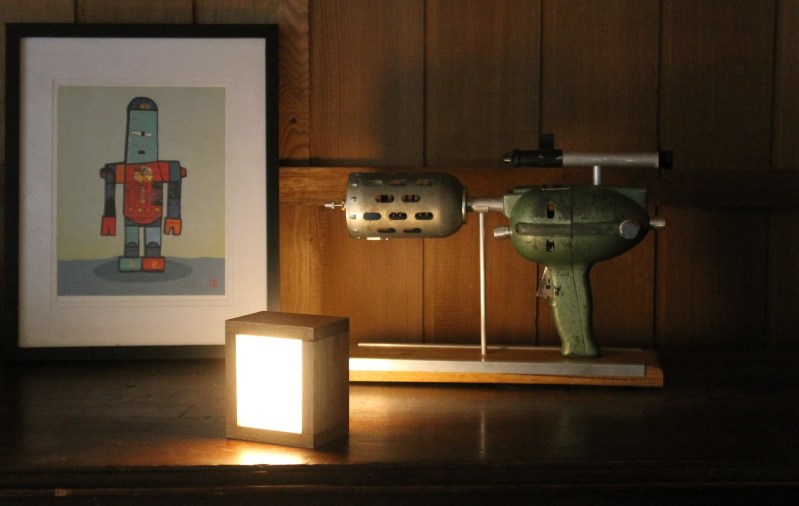Hit up the lighting aisle of any big box hardware store these days and you’ll probably find a variety of Edison bulbs — modern bulbs meant to evoke the bare, complicated tungsten filament bulbs from the early days of electric candlelight. Edison bulbs use filament LEDs, which resemble skinny candles with wicks at both ends and give off a nice light, especially when diffused by acrylic.
 This simple light box uses two filament LEDs that float inside on an internal circuit sculpture. [lonesoulsurfer] likes to use old cell phone batteries and USB charging boards in his builds, and that’s exactly what’s inside this box.
This simple light box uses two filament LEDs that float inside on an internal circuit sculpture. [lonesoulsurfer] likes to use old cell phone batteries and USB charging boards in his builds, and that’s exactly what’s inside this box.
Our favorite part of the build elevates this simple light box into a curiosity for those not in the know. It’s controlled with a mercury tilt switch, so all you’d have to do in a power outage is locate the box and turn it upside down, provided it has a charge.
We love elemental switch design around here, like this light box that switches on with salt water.















When those filament LEDs were newer, they seemed to only be available in series-wired, 70v+ models. I’m excited to learn that 3v ones are readily available now!
It is interesting that you can’t seem to find these as a normal part # like the common LEDs (at least I couldn’t find any). Sure you can find the 3V ‘bulbs’ here and there but not just the filament LEDs except on ebay. Obviously one could buy the bulb, break, and salvage…. A bit more expensive way to go…. I’d like to get my hands a few for fun too.
There’s been a shift in the design of LED bulbs where they dropped the module voltage down to get better power factor and less stroboscopic light out of the bulbs.
The earlier models were designed for 70+ volts so they’d be on for roughly 50% of the 120 Volt half-cycle of a wave with a simple linear current limiter, and with two strings of opposite polarity they would quite literally shimmer and blink on and off at 120 Hz as a result.
The later models started using ASIC chopper circuits that use some series impedance as a ballast to keep the current down with higher efficiency, so they could use lower forward voltage for the diodes and a higher duty cycle. The yellow phosphor coating bridges the remaining gap in output, at least for for yellow light. The blue end of the spectrum still blinks, but this is not so apparent.
They’re now using 30 Volt filaments. Where the 3 Volt filaments come from, I don’t know. Possibly they exist because of DC 12 Volt RV lightbulbs.
Everything I know about the turn on voltage of LED’s puts it at 3 and a half or so volts. Most importantly it varies a tiny amount for each LED. Cheap flashlights have a bunch of LED’s in parallel protected by a low ohm resistor so the lowest forward voltage LED burns out first. All proper LED arrays are series only and thus at voltage dropped form line voltage. In automotive use 3 LEDs in series and about 120 ohm gets the job done.
Any flashing or strobing in a light is the result of not using a proper AC to DC power source and HF chopper-regulator. It doesn’t matter weather in planer heatsink “bulb” or these “filament” style lights. I understand they have a cooling gas inside those vintage look bulbs to conduct heat off the LEDs to bulb surface. LEDs running without heatsinks, you’re kidding! Wave your hand under the light. See your fingers look weird or just smooth blur. These cheap LED lights give off a bad light and reputation of LED lighting in general to a lot of the public.
Until efficiency is near 100% heat has go somewhere. Until forward voltage is perfectly uniform, LEDs will have to be run in current controlled strings of series LEDs.
Yes,
but tell us about the drill/ray gun in the background of the title photo!
Okay, found it!
https://www.instructables.com/id/Ray-Gun-With-Sound-Effects-V2/
The title had me excited for a lamp with a built in SCM server
Nice light!
How much current can a mercury switch safely handle?
Quite a lot. The type that was used in the lamp is typically rated for 125 Volts and 2-3 Amps.
The limit is how much arcing the contacts can take before the thin leads start to melt inside the bulb.
Mind, the DC rating is going to be lower because the arc lasts longer.
we need a better solution than mercury! ugh!
I prefer git to mercurial
How about a reed switch with a magnet on a string. Turn it upside down and the magnet falls into place next to the switch. Something along those lines should work. Maybe a little box twice the diameter of the battery that sits halfway over the reed switch, that way the magnet never smashes into the switch but can slide down into place. Lots of easy solutions to this problem.
What I like about instructables is that they don’t bother you with “we value your privacy” or related popups. I don’t know what they do instead, but at least my browsing experience is not interrupted, nor am I forced to accept T&Cs I never read to also not interrupt the browsing expererience.
On topic: I like the dremel routing attachment, I didn’t know that existed. Also the different form factor LEDs are exciting.
nice find!